In March of 1959, John Glenn entered the isolation chamber. Flown under great secrecy to Wright-Patterson Air Force Base, Glenn was one of thirty-two men vying for an airborne slot in Project Mercury, the inaugural mission of the newly minted federal agency NASA. At Wright-Patterson’s Aero-Medical Laboratory, this group of all white male military test pilots underwent extensive psychological and physiological testing. Glenn had spent the week alternating between acceleration (enduring simulated lift offs) and interpretation (finding form in the ink blots of a Rorschach test) before being ushered into the room serving as an ad hoc solitary cell. Alone in the dark chamber, its walls insulated against sound, Glenn drifted into reverie, his head wreathed by the leads of an electroencephalogram (EEG).
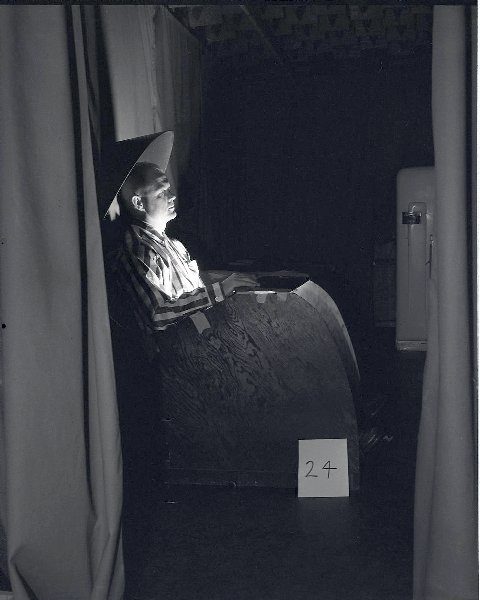
Stationed outside the door, listening over an intercom and watching ink scratches playing across the paper scroll of the EEG was Captain George E. Ruff. A psychiatrist at the Aero-Medical Laboratory, Ruff had been recruited to administer the psychological testing of prospective astronauts, closely observing as subjects performed physiological feats of endurance and the cognitive labor of monitoring ersatz instruments. Prospective astronauts were not informed in advance of the isolation chamber and given intentionally ambiguous details of its purpose. They were only asked to remain alone in the room as long as they could, usually around four hours.
In the early Cold War, the wars of the future were already being fought by men in isolation. American pursuit of a high-technological strategy imagined far-flung and exotic places – the Arctic, the deep sea, outer space – as new terrains for warfare. Indeed, prior to the founding of NASA, space was imagined by the US Air Force as a military geography where soldiers safely ensconced in orbiting satellites might conduct war at a distance, monitoring the upper atmosphere for signs of nuclear attack and launching intercontinental ballistic missiles of their own. Space, like other ‘hostile environments,’ was replete with unique physiological and psychological hazards. Ruff was adamant that the ‘chief psychological problems [of life in space] will be isolation and prolonged exposure to danger.’ [1] Alone and set adrift from the earth, the astronaut might be uniquely vulnerable to the effects of boredom, monotony and loneliness.
Isolation, however, became a hazard of outer space by way of an imagined Communist prison. The ostensibly coerced public confession of war crimes by a number of prisoners captured by Communist forces during the Korean War sparked public anxiety, casting doubt on the reliability and moral character of American soldiers. This crystallised in a cultural imaginary of ‘brainwashing’, involving sophisticated techniques of behavioural modification allegedly deployed by sinister Soviet forces and their allies to plant false information in the minds of Americans and prompt defection to the Communist cause. Quickly becoming a recurrent trope in film and fiction, brainwashing acted as a catalyst within the human sciences, opening new and deep pocketed sources of funding— largely surreptitiously from intelligence agencies— for psychologists, psychiatrists, and social scientists working on related areas.
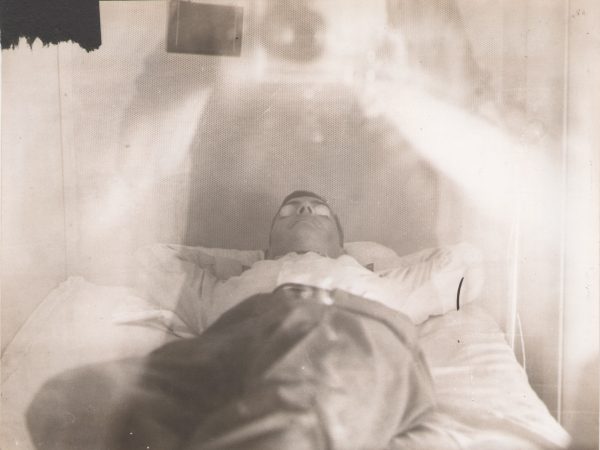
Prominent psychologist Donald O. Hebb capitalised on these new clandestine funding sources, obtaining a small sum of money from the Canadian Defense Research Board to study solitary confinement. These experiments, conducted by his graduate students and post-docs, used the raw material of McGill undergraduates to model captivity within the laboratory as a form of ‘perceptual isolation’, later rechristened ‘sensory deprivation’. Monotonous (and therefore effectively absent) sensory stimuli such as the ‘four bare walls’ of the prison cell was central to the psychological and neurological effects charted by Hebb’s students: a remarkable decline in cognitive performance, an ominous suggestibility, and, unexpectedly, vivid and bizarre hallucinations.
This work proved to be sensational, spurring countless replications in laboratories across the world. For some, the isolation apparatus offered a medium through which the sciences of mind might be gathered together for interdisciplinary research and brought to bear on a multiplicity of problems where a limited sensory environment was thought to be key— from the regression that might occur on a psychoanalyst’s couch to the ‘under performance’ of school children in urban, low-income environments. For military psychologists, isolation was a test to be passed, a mechanism through which the reliability of the soldier might be measured and observed.
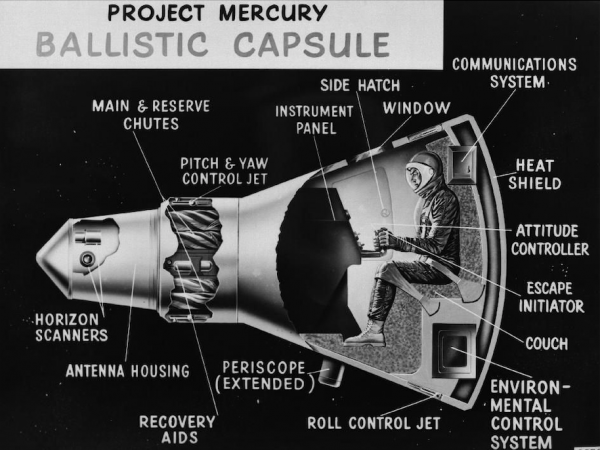
Having performed over a hundred iterations of similar experiments in isolation at the Aero-Medical Laboratory, George Ruff had come to view the project in terms of personality psychology. Isolation functioned much like a projective test; the subject was
confronted with an indefinite, rather unstructured emptiness which he then ‘fills with himself.’ He uses characteristic modes of operation or devices of defense and exaggerates them to become, in a way, ‘more like himself.’ [2]
In this fashion, the isolation chamber served two purposes: a simulation of the monotony and solitude that was imagined as definitive of life in space and a medium through which the ‘integrity’ of the astronaut’s ego might be both tested and rendered as data for the observing scientist. What one did in isolation was scientific evidence of who one really was.
Feeling his way around the dark room, Glenn—who would later become one of the first men in space and, later still, the senator of Ohio for some twenty years— soon found a desk and a legal pad. [3] Digging in the pockets of his khakis, Glenn realised he had inadvertently smuggled in a pencil and began to document his isolation. Writing in long hand crabbed by the darkness of the room, he mused that
it is so seldom these days that we get a chance to really be alone and think about the things that really count.
After trying in vain to locate the source of a mysterious hum, producing visible sparks of static electricity by ripping pages from the notebook— ‘a good long one that time!’ — and noting that he couldn’t ‘help but think of Helen Keller’, Glenn began to write poetry, a form of ‘mental gymnastics which at the same time accomplishes something.’ In a paean to science, he scrawled,
To mankind’s ever broadening store of knowledge, one must give/ his own peculiar talent, so that all may better live
before, growing bored, he folded much of the remaining pages of the notebook into paper airplanes and threw them across the room.
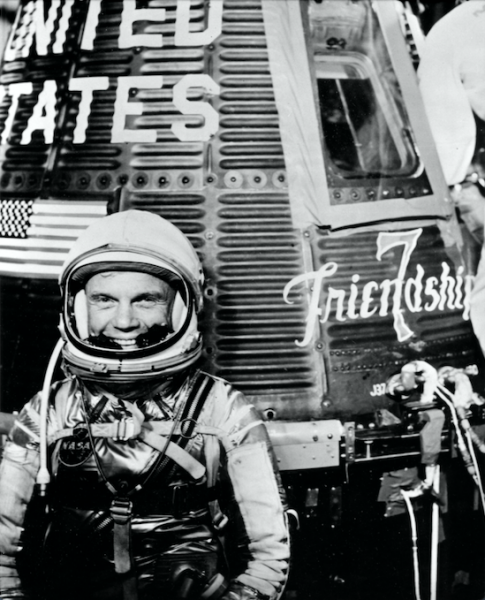
Much to his credit, Glenn intuited that this was both an exercise in constraint and an empty canvas onto which he was expected to paint himself as an astronaut. Glenn, often referred to by his more easy-going peers as ‘the Boy Scout’ was happy to oblige, already preoccupied with fashioning himself as a square jawed, squeaky clean exemplar of American masculinity. Others proved less creative, finding the experience baffling and using the unstructured time to take a mildly illicit nap. At least one candidate, Pete Conrad, was disqualified for having, in Ruff’s expert opinion, a personality ill-suited to the isolation of space. It should be noted that Conrad was accepted as an astronaut for the Gemini missions a few years later and would briefly hold a record for duration of time spent in orbit, exhibiting little of the imagined effects of isolation.
Whether the isolation chamber could provide a useful simulation of the monotony of space was uncertain, if not doubtful. Several of Ruff’s scientific peers launched withering critiques, citing both the continued presence of stimuli and the relative absence of danger, something certainly endemic to both space flight and solitary confinement. [4] Indeed, the stakes of this simulation seemed remarkably ambiguous to the prospective astronauts under Ruff’s watchful eye. Future astronaut Wally Schirra later wrote, ‘I have no idea how long I was in that room or why I was there, nor did I care.’ [5] For Ruff, this was useful information in itself.
For NASA, isolation ceased to be a hazard of space following these first successful flights. NASA’s official technical report concerning Glenn’s orbit around the Earth states succinctly that ‘no sensory deprivation […] was noted.’ [6] By Gemini and the next round of space flights, this was beneath mentioning. Sadly, Ruff, who had left the Air Force following Project Mercury and expected to have a career within the civilian agency, found himself largely unwelcome in space science circles. Relegating psychiatrists to ‘screening out’ potential mental illness, NASA would not conduct another formal study of the personalities of astronauts until 1987. This study did not include an isolation chamber.
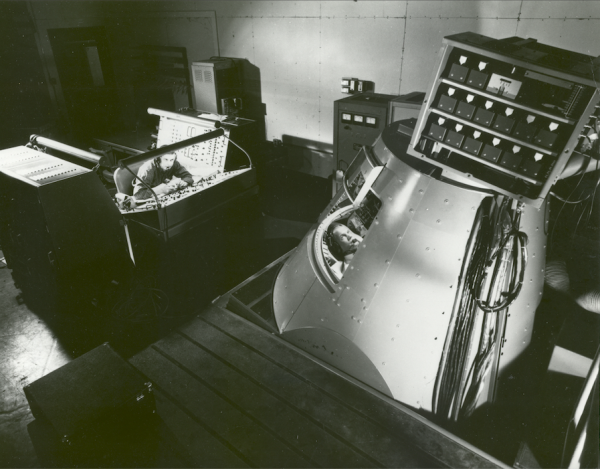
For a brief moment in the late 1950s, scientific interest in isolation cannily dramatised all that remained beyond the reach of the notoriously control-obsessed American space program: the human psyche. Isolation continued to shape the cultural context in which space flight was understood for much of the next few decades. Indeed, the first ‘Twilight Zone’ episode, aired several months before Glenn arrived at Wright-Patterson, featured an ersatz astronaut in an isolation chamber having a vivid and extended hallucination of being the only person on earth, a shattering experience of loneliness. As the unfortunate experimental subject is carted away on a stretcher, an observing psychiatrist speaks into the camera,
we can feed stomachs with concentrates. […] We can pump oxygen in, waste material out. But there’s one thing we can’t simulate. That’s a pretty basic need — man’s hunger for companionship, the barrier of loneliness. That’s one we haven’t licked yet.
In his closing monologue, as the camera slowly pans toward the stars, host Rod Sterling, himself a former test pilot, intones that
up there in the vastness of space, in the void that is sky, up there is an enemy known as isolation.
[1] Ruff, George E. “Psychological Effects of Space Flight.” Aerospace Medicine, July 1961.
[2] Ruff, Captains George E., et al. “Studies of Isolation and Confinement.” Aerospace Medicine, Aug. 1959.
[3] “John Glenn’s notes from isolation room, 1959,” folder 39, box 69, Non-Senate Papers Sub-group, John Glenn Archives, Ohio State University.
[4] Psychiatrist Jay Shurley, for one, was highly critical of Ruff’s work. Shurley assisted with the concurrent physiological and psychological testing of prospective female astronauts—most notably, Gerri Cobb– using his own water immersion isolation apparatus; in his opinion, this was a far superior simulation of the solitude of space.
[5] Schirra, Wally, and Richard N. Billings. Schirra’s Space. Naval Institute Press, 1995, 61-62.
[6] “Technical Results of the First Manned Orbital Flight from the United States,” undated but presumably 1962, Source Files on Project Mercury 1952-1968, Records of the National Aeronautics and Space Administration, National Archives, 97.
Jeffrey Mathias is an AHA/NASA Space History Fellow and a PhD Candidate in Science and Technology Studies at Cornell University. He tweets @cheffmathias